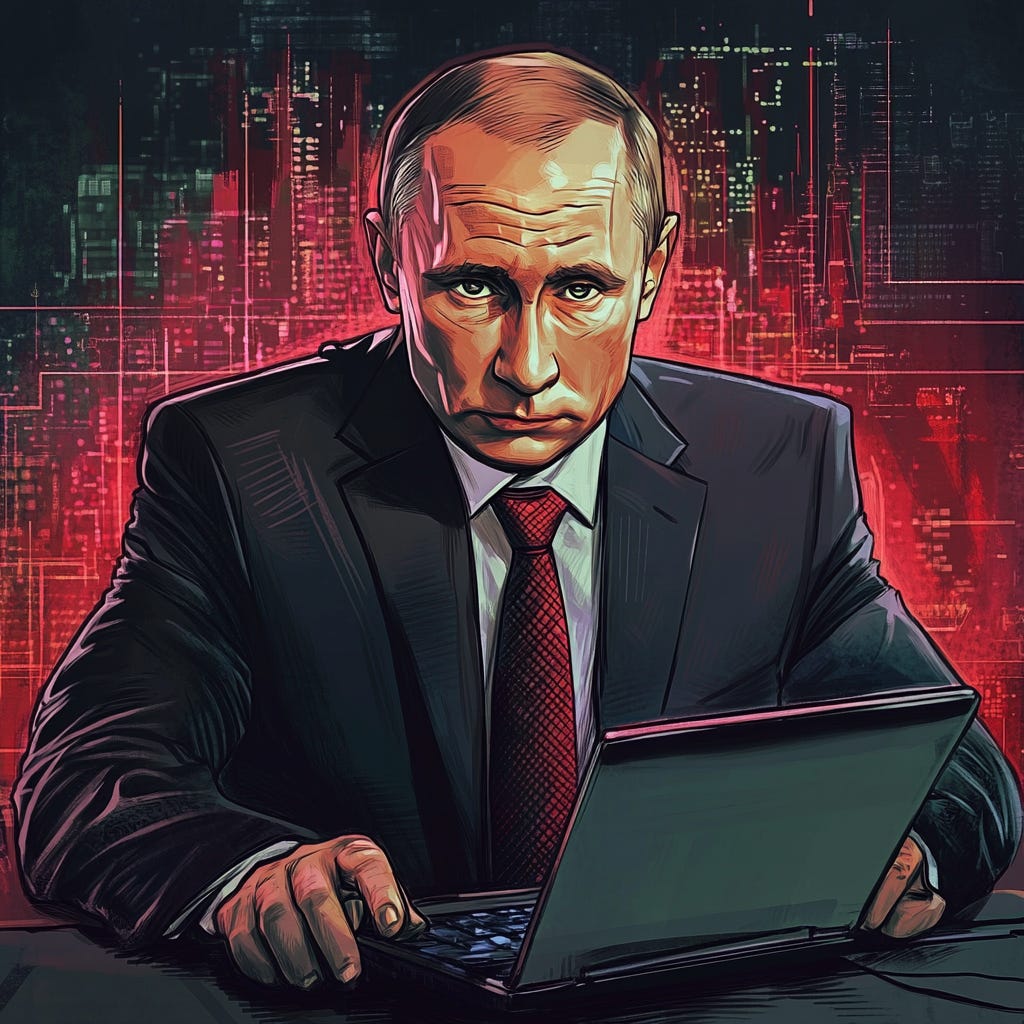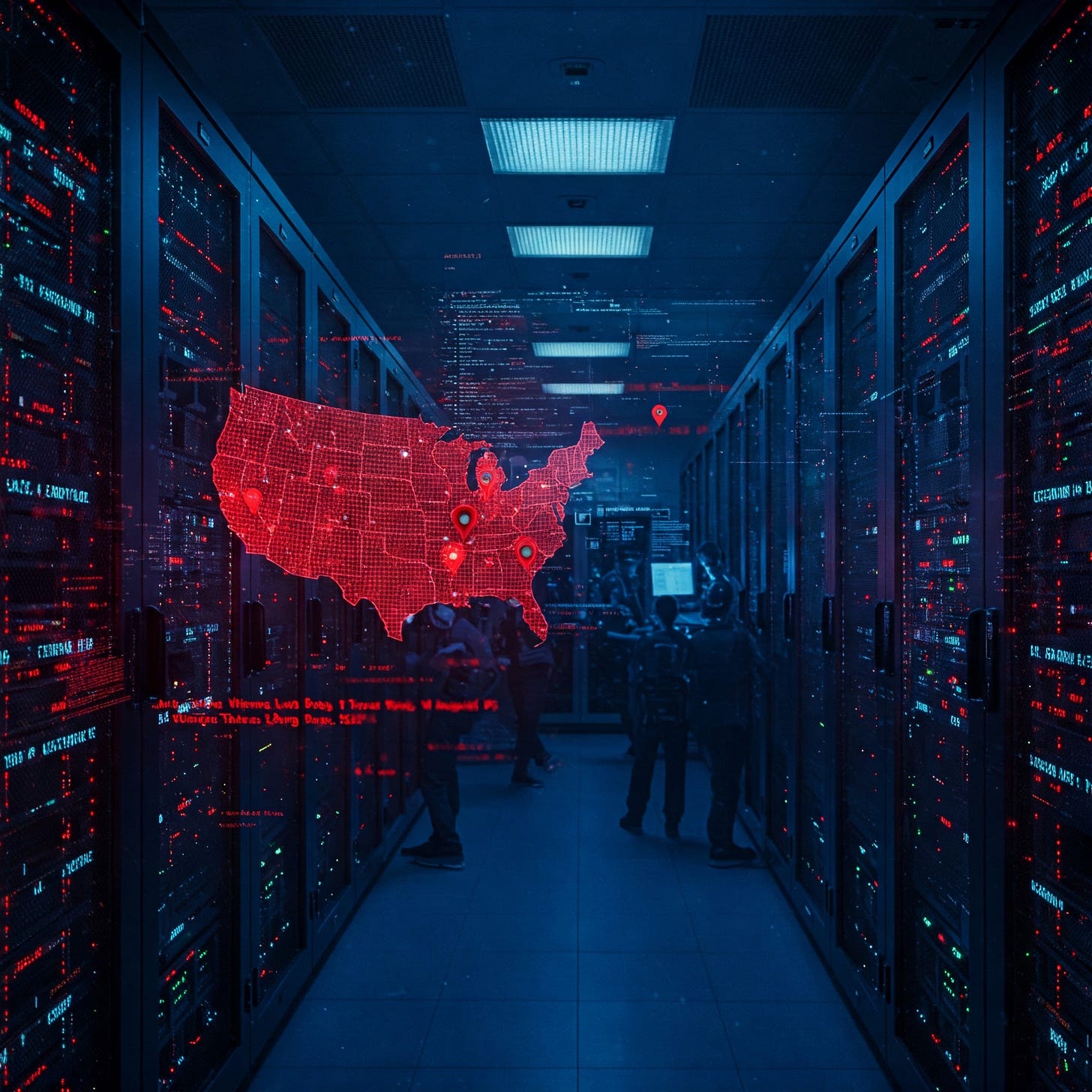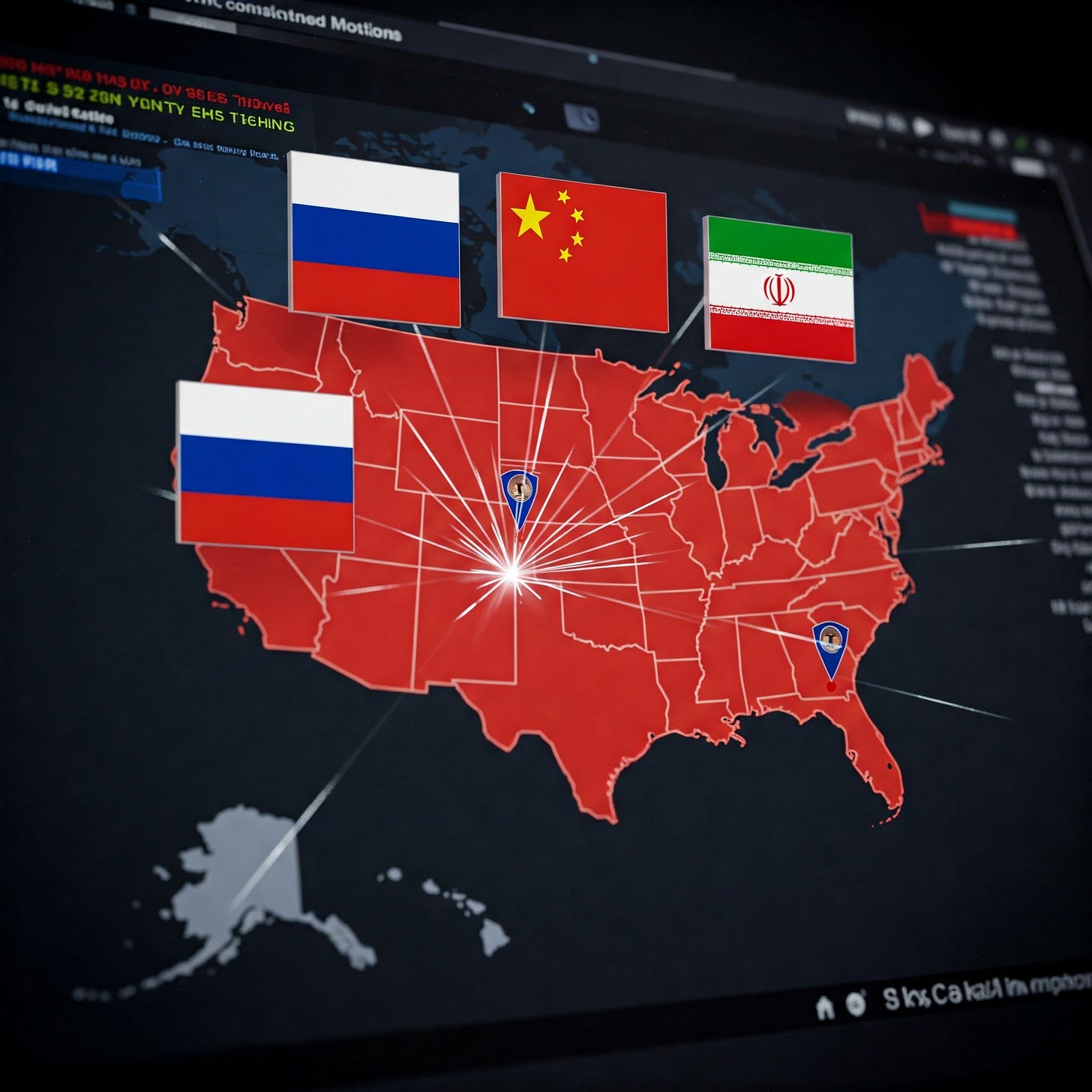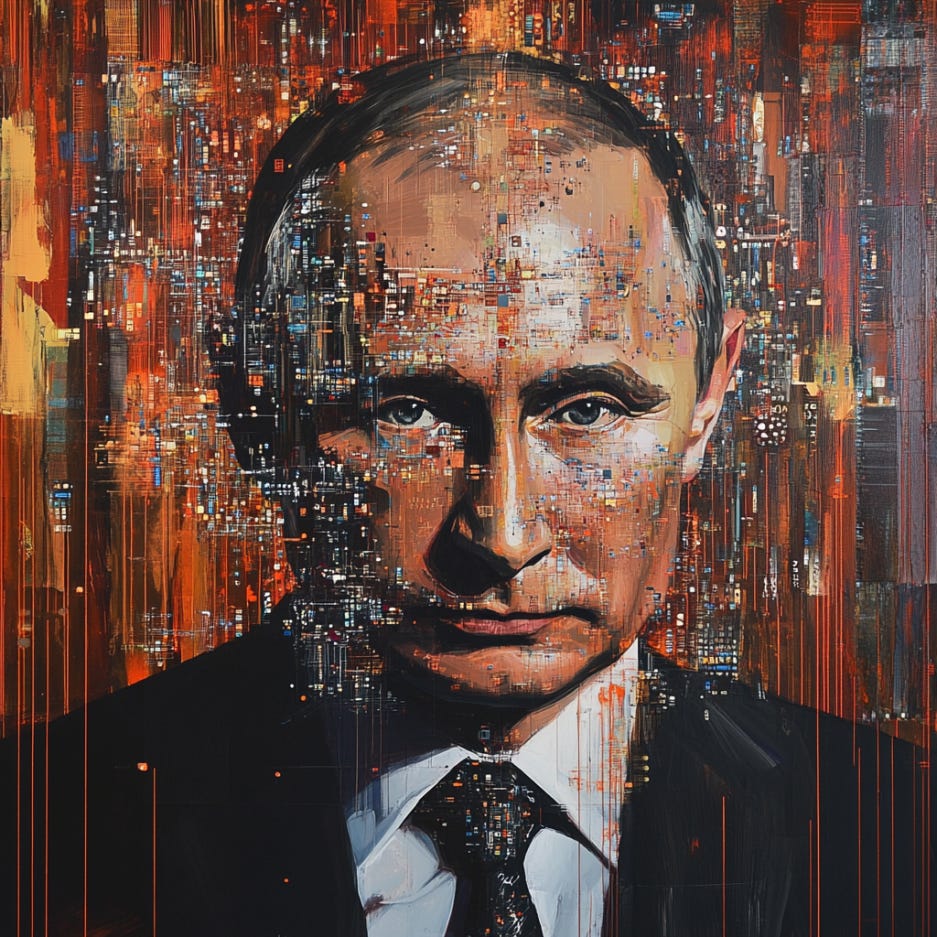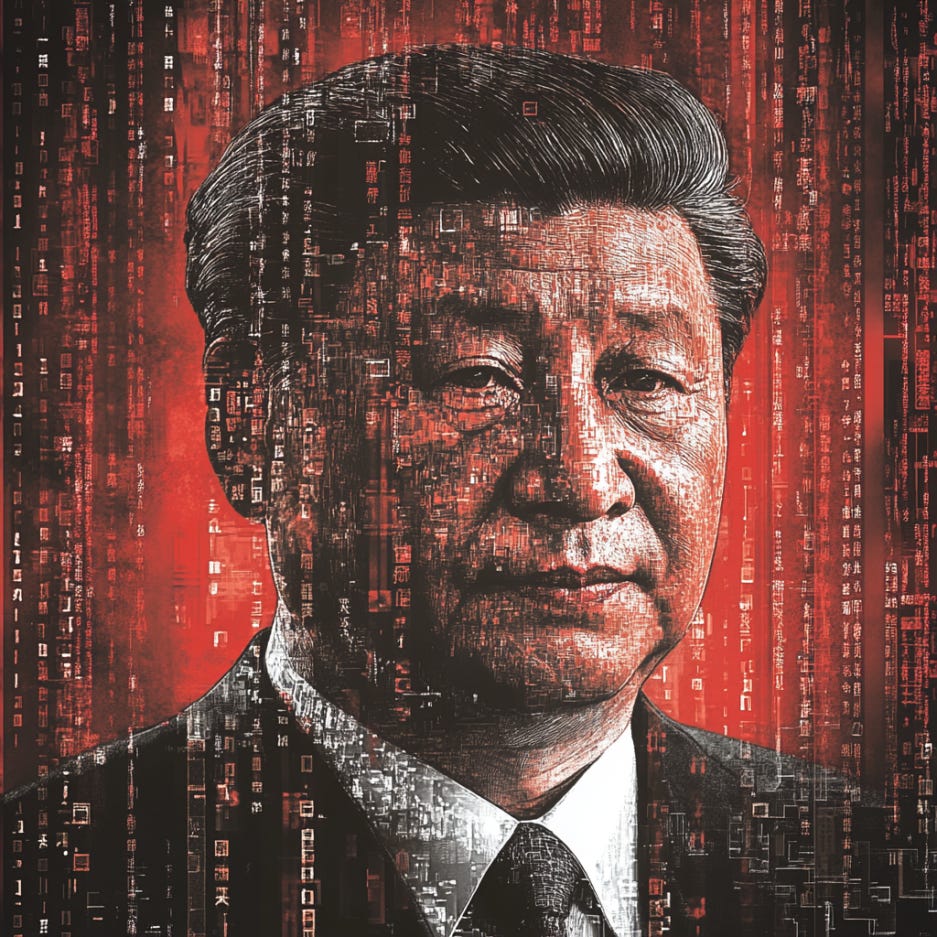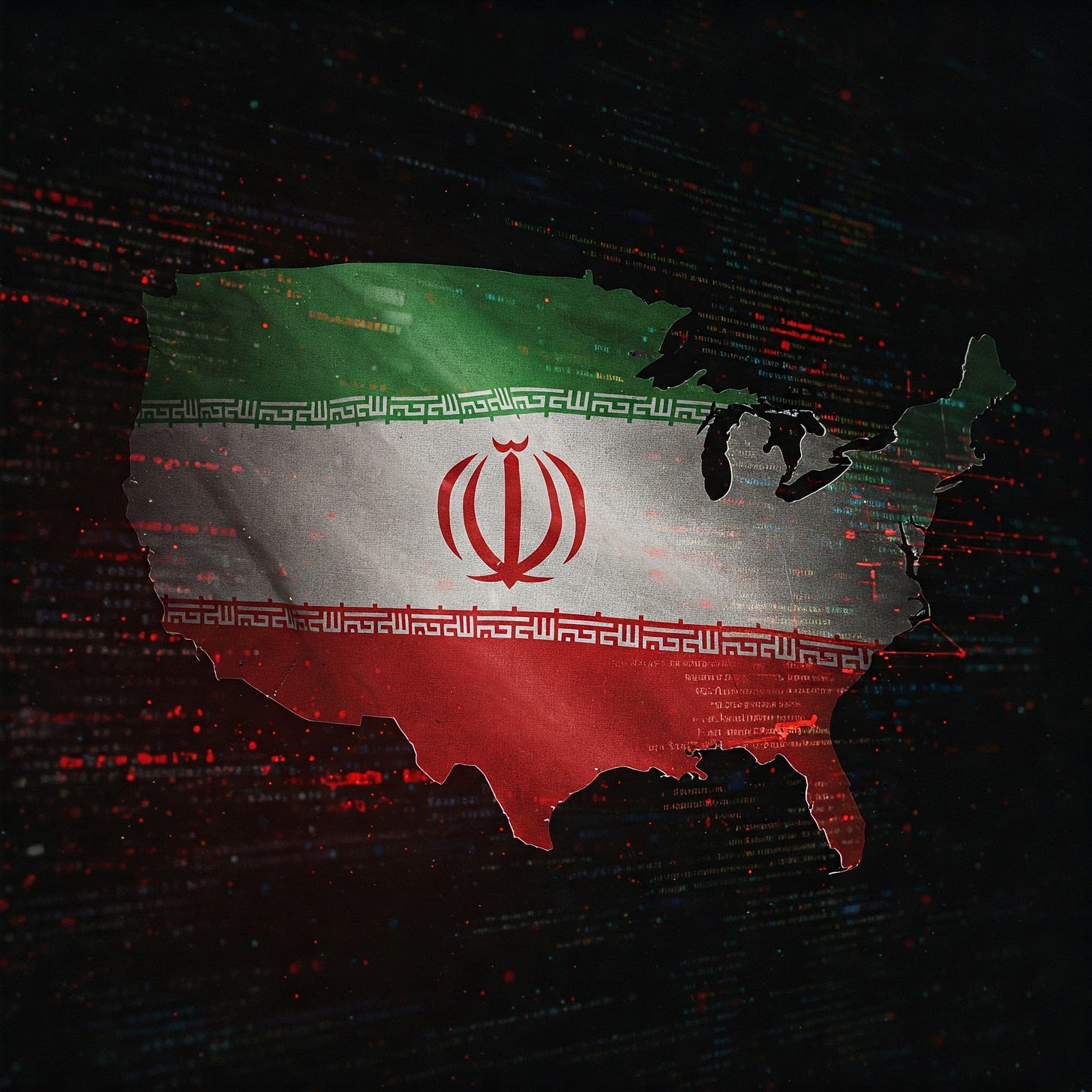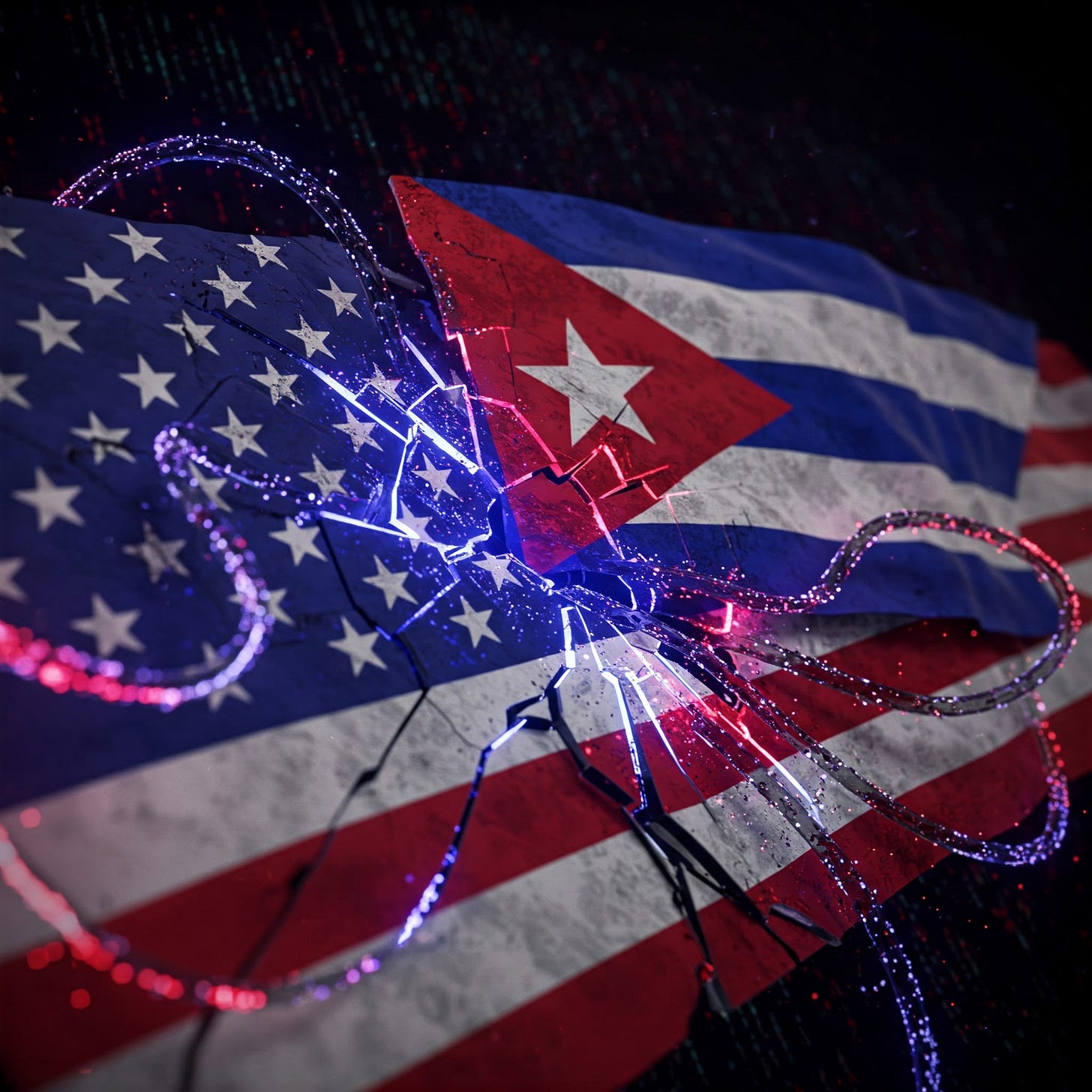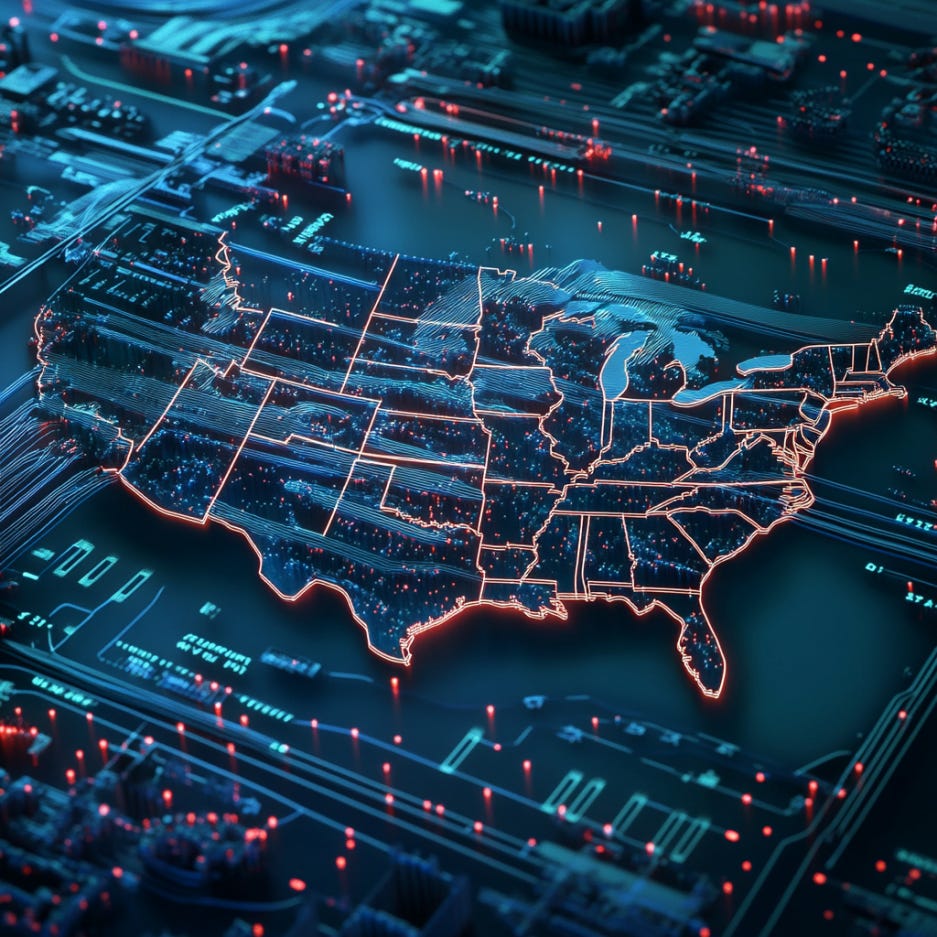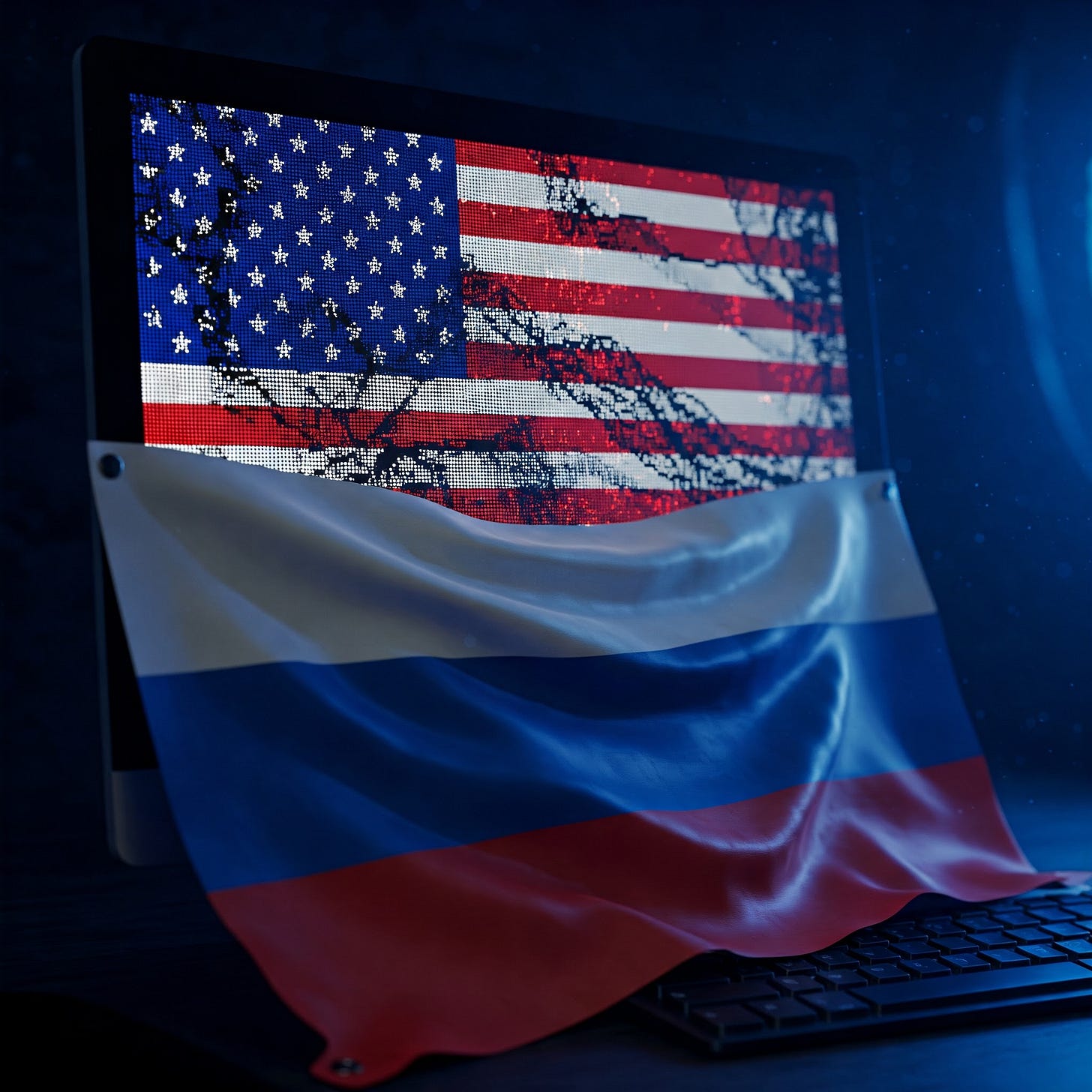Foreign Interference in the 2024 U.S. Presidential Election: Trump vs. Harris (Russia, China, Iran, North Korea, Cuba)
Which countries attempted to sway the 2024 U.S. presidential election? Were they effective?
It should be obvious to most that select foreign countries like Russia, China, North Korea, et al. meddle in U.S. politics and try to sway the outcomes of presidential elections.
The 2024 election between Donald Trump and Kamala Harris was high-stakes for some countries, and arguably highest stakes for Russia. For this reason, Russia dedicated in excess of $1.5 billion to push propaganda on U.S. social media to help Donald Trump get elected.
A comical reverse psychology “psyop” that many right-wingers (conservatives, republicans, etc.) and self-proclaimed “moderates” fell for was that Putin really wanted Kamala Harris to win the 2024 U.S. Presidential election.
How did they fall for it? They aren’t very bright… and they just take Putin’s words at face value: Putin stated he wanted Harris to win in 2024. He noted that she "laughs so expressively and infectiously" and suggested that her good humor may result in fewer sanctions against Russia.
Putin also falsely claimed that Trump imposed more sanctions on Russia than any other U.S. president… Putin with the fairly effective reverse psychology (“See! Putin really wanted Harris to win! Trump is way tougher on Putin and Russia! Nobody is tougher!”)
Use a modicum of logic and it’s braindead obvious who Russia/Putin wanted to win: Trump. The right-wing (Trump backers) are highly skeptical of Zelenskyy (many conspiracy theories) and don’t want American money going to Ukraine (or anywhere outside the U.S. for that matter).
Trump historically has favored U.S. isolationism (less resistance for Russia expansionism), has been open to working with Putin (willing to negotiate/meet with him), stated that he’d end the war (Ukraine-Russia) — and work out a deal. Many Trump backers also have questioned whether the U.S. should withdraw from NATO (Russia loves hearing this… even if doesn’t happen, at least there’s a darkhorse Hail-Mary-type shot under Trump).
Kamala Harris pledged to continue supporting Ukraine & Zelenskyy (Zelenskyy was on the campaign trail with Biden in 2024 in PA). Would make zero sense for Putin to support Harris. (If you are in Putin’s shoes, who are you supporting? It’s a no-brainer.)
What about other countries? China tends to prefer stability… but there’s no clear evidence that they favored either U.S. presidential candidate in 2024. If I had to guess? I think they would’ve preferred Harris because she’s more predictable (Trump is a wild-card). But if they think Trump was more likely to do something stupid, perhaps they’d have preferred him (swoop in for trade deals & alliances if Trump goes full isolationist).
Iran attempted to interfere in the election as well and they 100% wanted Harris to win… Why? Trump has been tougher than anyone on Iran — and ordered the assassination of Qasem Soleimani in 2020. Trump thinks Iran was trying to assassinate him (seems very plausible) and gave his advisors instruction for Iran to be obliterated if they assassinate him (smart move).
Evidence suggests Cuba undertook modest efforts to boost Harris — as she aligns more with communist ideals and they have a better chance at doing deals with her than Trump. North Korea wanted Trump probably because Kim enjoys the bizarre TMZ-style celeb relationship with Trump and preexisting rapport.
I. 2024 U.S. Presidential Election Interference
The 2024 U.S. presidential election saw broader, more technologically advanced foreign interference than in previous election cycles (2016 and 2020).
Adversarial states—including Russia, China, Iran, Cuba, and North Korea—engaged in campaigns designed to shape voter perceptions, shift public narratives, and potentially alter voting behavior.
Russia concentrated on sowing discord and reducing U.S. support for NATO and Ukraine, favoring the Trump campaign to maximize geopolitical advantage.
China pursued a more issue-centric approach, seeking to influence down-ballot races and U.S. policy debates (especially regarding Taiwan), rather than overtly supporting one presidential candidate.
Iran launched aggressive hacks and disinformation efforts to undermine Donald Trump, owing to Tehran’s hostility toward his “maximum pressure” strategy and the 2020 killing of Iranian General Qasem Soleimani.
Cuba targeted its messaging at Cuban-American communities to nudge them toward Democratic candidates who might ease sanctions and the decades-old embargo.
North Korea mostly stuck to cyber espionage, apparently leaning toward Trump on the chance of continuing the unpredictable (but occasionally conciliatory) diplomacy that typified Trump’s earlier engagements with Kim Jong-un.
While these efforts were sophisticated and often brazen, most intelligence estimates put their combined effect on actual voting outcomes at 1–2%—a margin overshadowed by domestic factors such as partisanship, economic concerns, and candidate-driven campaigning.
However, even a seemingly small shift could matter in razor-thin swing states, and the “soft power” impact—eroding trust in U.S. democracy and amplifying polarization—was considerably higher than raw vote shifts alone would indicate.
A.) Key Findings (Net Impact & ROI)
Marginal Direct Vote Impact: Despite multi-pronged foreign meddling—ranging from hack-and-leak attacks to AI-enabled disinformation—the consensus among experts is that none of these foreign states decisively flipped the presidential election results. The estimated shift in voter preferences stayed under 2%.
Strategic ROI: In terms of strategic payoff:
Russia effectively stoked divisions and challenged U.S. commitments abroad, consistent with the Kremlin’s goal to destabilize Western alliances.
China advanced a more diffuse strategy, using disinformation primarily to mold the U.S. policy landscape in ways that could benefit Beijing, especially concerning Taiwan.
Iran successfully undermined Trump’s campaign narrative to some degree but mostly succeeded in portraying the U.S. as chaotic and dysfunctional.
Cuba made incremental gains among Spanish-speaking audiences in Florida, though on a smaller scale than the other major actors.
North Korea gleaned intelligence from cyber-espionage, but had limited ability to shape the broader U.S. electorate.
Long-Term Effects: Even if foreign influence didn’t tip the 2024 results, these propaganda “psyops” further polarized U.S. political culture and planted deeper doubts about the electoral process—effects that can reverberate for years. Such doubts create a strategic vulnerability that hostile actors can exploit in future cycles.
Could Russia have won Trump the election in 2024?
Theoretically yes — but in reality? I’d guess probably not. Experts estimate the total propaganda may have influenced votes by <1-2% — but not all of the propaganda was Russian… China, Iran, and Cuba may have been hoping for different shifts, thereby negating some of the outsized Russian impact.
In other words, we don’t know if Russia shifted votes towards Republicans by 1-2% more than any actors aiming to shift votes the opposite way. We also don’t necessarily know the magnitude of efficacy in swing states — perhaps Russian propaganda was far more/less effective in swing states.
Nonetheless, it is theoretically possible that Putin et al. helped Trump secure the bag in 2024. Under 2% margins in 3 swing states.
Wisconsin: 49.7% Trump vs. 48.8% Harris (Margin: 0.9%: 29,397 votes)
Michigan: 49.73% Trump vs. 48.31% Harris (Margin: 1.42%: 80,103 votes)
Pennsylvania: 50.37% Trump vs. 48.66% Harris (Margin: 1.71%: 120,226 votes)
B.) Countries Involved & Motivations
Russia:
Objective: Weaken U.S. democracy and alliances; secure a potentially friendlier administration vis-à-vis Russia’s interests in Eastern Europe.
Candidate Preference: Donald Trump, given his past skepticism of NATO and the West’s unified response to Russia’s actions in Ukraine.
China:
Objective: Influence key policy areas (Taiwan, trade, global economic leadership). Reduce chances of a large-scale “hardline” coalition forming against Beijing.
Candidate Preference: Officially none; behind the scenes, intelligence suggests a slight preference for Kamala Harris due to predictability.
Iran:
Objective: Prevent the return of a Trump presidency likely to perpetuate (or intensify) maximum sanctions and confrontational postures.
Candidate Preference: Kamala Harris. Trump is notoriously tough on Iran.
Cuba:
Objective: Mitigate or end U.S. embargo policies, secure a friendlier administration open to re-engagement.
Candidate Preference: Kamala Harris. Democratic platforms typically allow for diplomatic openings with Havana.
North Korea:
Objective: Obtain negotiating leverage, possible relief from sanctions, and exploit potential U.S. distraction or internal division.
Candidate Preference: Quietly Trump, given the unconventional summit diplomacy of Trump’s earlier term, albeit with limited direct interference capacity.
C.) Comparison With 2016 & 2020
2016: Set the stage with Russia’s DNC hack and troll farm operations, elevating foreign interference into mainstream U.S. discourse.
2020: Various actors (particularly Russia and Iran) deployed smaller but still significant operations. The U.S. responded with somewhat better defensive coordination.
2024: Marked by extensive use of AI, advanced social media tactics, and an unparalleled volume of disinformation. Nevertheless, the heightened vigilance from U.S. agencies and tech platforms curtailed the scale of impact observed in 2016.
II. Research Methods & Sources
I’m sure plenty of people will claim “biased” or “psyop” sources and research or whatever. But just because a publication may have a slight political tilt does not automatically mean information is inaccurate.
I’m sure some on the right will claim something like “you can’t trust any of these sources” (so by default they trust their gut feeling and/or whatever some random poster on X thinks… who might be a Russian propagandist). If you don’t trust any sources, who are you trusting? If you trust no one how do you make any decisions?
And I’m sure left-wingers will claim that Russia is the biggest problem because they spread propaganda to help Trump… but I’m not convinced they’d think of it as a major problem if it had been in favor of Kamala Harris.
I tend to trust left-wing investigations on Russia because Russia clearly wanted Trump to win… so the left was going all out trying to detect propaganda and put the fires out before they gained too much momentum.
A.) Intelligence Assessments & Academic Research
Declassified briefings by the Office of the Director of National Intelligence (ODNI), Federal Bureau of Investigation (FBI), and the Central Intelligence Agency (CIA).
These agencies collectively monitor foreign signals intelligence, track digital footprints of known adversary networks, and combine human intelligence with cyber forensic analysis.
Academic research—from institutions such as the Atlantic Council’s Digital Forensic Research Lab and the European Union Institute for Security Studies (EUISS)—provides deeper context on how social media manipulation and strategic narratives are deployed across various platforms.
Peer-reviewed and government-commissioned studies incorporate quantitative methods (e.g., measuring shifts in public sentiment online) and qualitative interviews (e.g., with tech company threat analysts).
B.) Media & Investigative Reporting
Reputable news organizations—including Reuters, the Associated Press, the New York Times, the Washington Post, NBC News, and CBS—played a crucial role in exposing emerging hacking campaigns, troll farm footprints, and suspicious “dark money” activity.
For instance, Reuters broke the story on U.S. Treasury sanctions against Russian and Iranian entities on December 31, 2024.
The AP and Washington Post documented Iranian hack-and-leak attempts targeting the Trump campaign.
NBC highlighted the takedown of Chinese “Spamouflage” networks on Facebook and X (Twitter).
C.) Government Statements, Indictments, Sanctions Disclosures
Official government documents are a cornerstone of this analysis.
Department of Justice (DOJ) indictments unsealed in September and October 2024 named specific foreign operatives from Russia’s RT media outlet and Iran’s Islamic Revolutionary Guard Corps (IRGC)–linked hacking teams.
U.S. Treasury sanctions notices from late 2024 identified the Russian Center for Geopolitical Expertise (CGE) and an Iranian IRGC sub-unit, both implicated in election meddling via disinformation and hacking.
ODNI & CISA statements provided real-time alerts about active foreign influence campaigns, citing advanced AI usage and multi-platform infiltration.
D.) Tech Company Disclosures
Private-sector threat intelligence teams at Microsoft, Meta (Facebook), Google, and X (Twitter) supplemented official government data by:
Identifying malicious campaign clusters (e.g., large sets of inauthentic accounts traced to Russian or Chinese servers).
Issuing public takedown reports that described the scope and methodology of these networks.
Implementing updated election security measures, such as flagging suspect deepfake content, limiting the reach of unverified “viral” political posts, and cooperating with U.S. government agencies under the guidelines of the Cybersecurity and Infrastructure Security Agency (CISA).
The combo of these sources — government intelligence, academic analyses, media investigations, and tech company evidence — strengthen the credibility of conclusions drawn about the scale, nature, and ultimate impact of 2024 foreign interference.
III. 2024 Election Threat Environment
A.) Complexity of 2024
3 critical factors contributed to the increased complexity of foreign interference in 2024.
Deepened U.S. Polarization: Domestic political schisms provided adversaries with natural fault lines to exploit—whether racial, ideological, or socioeconomic. Foreign entities inserted themselves into hot-button debates (e.g., policing, COVID aftermath, election legitimacy), amplifying inflammatory rhetoric already generated within the U.S.
Advancements in Technology: The widespread availability of AI-based generative tools enabled adversaries to produce realistically deceptive audio, images, and videos. This empowered foreign trolls to create “deepfake” clips of U.S. politicians engaging in scandalous or controversial behavior, forcing campaigns and media outlets to devote resources to debunking them.
Better-Advised, More Adaptable Threat Actors: Countries like Russia and Iran benefited from lessons learned in 2016 and 2020, refining their tradecraft. They began using covert funding channels (e.g., laundering money through U.S. companies to pay local influencers) and approached election meddling more subtly—emphasizing “gray” propaganda and targeted leaks, rather than easily traced mass hacks.
B.) Role of Artificial Intelligence & Deepfake Technologies
AI drastically raised the stakes for disinformation:
Russia’s GRU (military intelligence) reportedly financed an AI lab in Moscow to churn out thousands of fake profile pictures and short “viral” videos to be posted on X (Twitter), Facebook, and YouTube.
Iran used deepfake techniques to “doctor” stolen emails from Trump campaign officials, making them appear more scandalous. These manipulated documents circulated briefly before forensic experts proved tampering.
China leveraged AI-driven “Spamouflage” to impersonate American activists, shaping policy conversations around Taiwan and trade. This approach allowed them to seed narratives quickly across multiple social media platforms.
The ease of AI-driven creation meant sheer volume multiplied. The “firehose of disinformation” was so vast that even well-resourced fact-checkers and government agencies sometimes struggled to track and debunk every false claim.
C.) Coordinated U.S. Government Defenses
In response to heightened threats, the U.S. implemented a multilayered defense.
Federal Fusion Centers:
The Foreign Malign Influence Center, launched in 2022, aggregated intelligence from NSA, CIA, and FBI, rapidly distributing actionable leads to other agencies, state authorities, and even major social media platforms.
Legal and Diplomatic Deterrence:
DOJ’s early indictments of Russian operatives funding a Tennessee-based media firm illustrated a “name-and-shame” strategy.
The State Department coordinated with European and Asian allies to expose cross-border disinformation networks, spotlighting how adversaries were “recycling” the same or similar narratives across different Western democracies.
Collaboration with Tech Firms:
Platforms like Meta, X, and YouTube used advanced AI detection systems to identify fake accounts, suspicious “bot-like” behavior, and deepfake videos.
Cybersecurity alerts about potential hacking attempts reached campaign teams quickly—CISA provided real-time situational updates to both Democratic and Republican campaigns, ensuring parity in threat awareness.
D.) Overview of Impact on Public Trust
While the direct effect on the election outcome remained modest, the barrage of foreign and domestic disinformation left many voters disoriented. Polls indicated a significant rise in the number of Americans doubting the integrity of U.S. elections—even more so than after 2020.
Election Legitimacy: A notable portion of the electorate continued to believe false narratives about widespread fraud, further amplified by foreign actors capitalizing on the confusion.
Civil Society Fatigue: Journalists, fact-checkers, and grassroots organizations expended immense energy combating misinformation—energy that might otherwise have been used to cover or discuss substantive policy issues.
Long-Term Vulnerability: The success adversaries had in normalizing the presence of false or manipulated information may have an enduring impact on how U.S. voters engage with future electoral processes and governance—reflecting a central objective of foreign strategic influence campaigns.
2024 underscored how foreign adversaries have become both more discreet and more technologically adept. Even if their net effect on actual votes appears small, the deeper damage to societal cohesion and collective trust in democracy remains a serious concern for national security experts and policymakers.
IV. Ranking Foreign Countries by Estimated Impact on the 2024 U.S. Presidential Election
In 2024, 5 primary foreign actors conducted varying degrees of interference aimed at influencing U.S. electoral outcomes. Intelligence and independent analyses place them on a spectrum of overall impact, taking into account:
Volume and sophistication of disinformation or hacking.
Scope of target audiences (e.g., national vs. localized).
Resources and covert funding deployed.
Potential for long-term “soft power” effects (e.g., deeper mistrust in institutions).
Included below is a ranked list from most impactful to least, with a short rationale for each.
1.) Russia
Highest Volume of Disinformation (“firehose” approach).
Use of AI-Generated Deepfakes and covert U.S. funding channels.
Major Hack Attempts aimed at competing campaigns.
Clear Candidate Preference (Trump).
Longstanding Track Record (2016, 2020, and now 2024) of advanced interference.
2.) China
Issue-Focused Strategy with sophisticated “Spamouflage” social media influence.
Down-Ballot Targeting: singled out hawkish or pro-Taiwan politicians.
Cyber Espionage against both major-party campaigns for intelligence leverage.
Less direct partisanship at the presidential level, but broad and well-funded.
3.) Iran
Aggressive Hack-and-Leak operation against the Trump campaign.
Significant Disinformation to exacerbate U.S. political and social divisions.
Strong Anti-Trump Motive stemming from sanctions and the Soleimani killing.
Though not as resource-heavy as Russia or China, still mounted notable interference.
4.) Cuba
Narrower Focus on Cuban-American communities.
Spanish-language misinformation seeking to shift opinions in Florida and other key Latino-heavy states.
Primarily aimed at securing a Democratic-leaning outcome for potential embargo relief.
5.) North Korea
Low-Volume Influence—mainly espionage rather than direct disinfo.
Strong preference for a leader more open to personal diplomacy (i.e., Trump), but with limited capacity to shape U.S. public opinion.
Primary gains were likely intelligence-based (stealing policy details, internal campaign strategies).
V. Deep Dives: Top 5 Foreign Interference Threats (2024 U.S. Election)
1.) Russia (Deep Dive)
Strategic Goals & Preferred Candidate
Objective: Russia seeks to weaken U.S. power and reduce Western unity, in line with the Kremlin’s broader worldview that portrays the U.S. as a declining hegemony. By undermining U.S. electoral integrity and fomenting distrust, Russia aims to erode America’s moral standing on the global stage.
Preferred Outcome in 2024: A Trump presidency or a similarly disruptive administration that questions NATO, reduces American support for Ukraine, and is more inwardly focused on domestic political crises.
Tactics
Disinformation Firehose
Scope & Scale: Expanded from 2020 levels, saturating U.S. social media and web forums with fabricated stories about Democratic candidates.
Narratives: Focused on crime, immigration, and “election fraud” conspiracy theories—topics already polarizing in the U.S.
Inauthentic Amplification: Paid local influencers and covert troll accounts posted content in pro-Trump spaces, fueling existing tensions.
AI-Driven Deepfake Campaigns
Key Player: Moscow’s Center for Geopolitical Expertise (CGE)—implicated by the U.S. Treasury.
Tech Tools: Used generative adversarial networks (GANs) to create false video evidence of Democratic leaders making racist or incriminating statements. Some videos went briefly viral before being debunked.
Objective: Force targeted campaigns to spend resources on damage control, hamper their message discipline, and sow confusion among moderate voters.
Covert Funding & Domestic Front Operations
RT-Linked Funding: DOJ indictments revealed how Russian state media employees funneled $10 million into a U.S.-based media company (known as Tenet Media in the indictment).
Purpose: To launder pro-Kremlin content through seemingly American voices—YouTube personalities, podcast hosts—who hammered narratives sympathetic to Russian foreign policy interests.
Cyber & Potential Physical Threats
Espionage: Although no major “DNC-style” hack came to light in 2024, Russian groups did attempt to breach the Democratic nominee’s networks.
Fake Bomb Threats: An FBI bulletin attributed at least one phoned-in polling place threat to Russian actors, aimed at creating chaos or deterring voter turnout in a battleground county.
Comparison with 2016 & 2020
2016: Russia famously hacked the DNC and Clinton campaign chairman John Podesta, then leaked stolen emails via WikiLeaks. Troll farms (Internet Research Agency) mounted large-scale social media manipulation.
2020: Interference was more subtle; fewer high-profile hacks but continued reliance on disinformation, especially to denigrate Joe Biden. Proxies in Ukraine (e.g., Andriy Derkach) helped push anti-Biden narratives.
2024: Marked by a return to mass-scale disinfo but with a heavier emphasis on AI and more covert funding of American influencers—less “in your face” hacking, more surreptitious infiltration of U.S. political discourses.
U.S. & International Responses
Legal Actions: The DOJ unsealed indictments on Russian nationals tied to RT in early September 2024, unveiling the “Tenet Media” scheme. This represents the first time the U.S. prosecuted foreign-funded domestic media infiltration at that scale.
Financial Sanctions: On December 31, 2024, the Treasury Department sanctioned CGE and its director. The designations froze any assets under U.S. jurisdiction and banned U.S. persons from interacting with them. Allies like the UK and EU applied complementary sanctions, further isolating the sanctioned individuals and entities.
Public Exposure: U.S. intelligence published bulletins naming Russia as the “most active” foreign election threat. The White House coordinated with tech companies, which in turn removed thousands of Russian-linked social media accounts.
Diplomatic Condemnation: NATO partners and the European Union collectively condemned Russian interference. While no immediate shift in policy (e.g., additional direct retaliation) followed, it reinforced a transatlantic consensus that Russia remains a persistent threat to Western democratic processes.
2.) China (Deep Dive)
Strategic Goals (Issue-Focused vs. Partisan)
China’s motivations differ from Russia’s in that Beijing’s objectives are more about shaping U.S. policies and less about overtly boosting one candidate.
Broadly, the People’s Republic of China (PRC) wants to:
Dilute Strong Anti-China Positions: Target U.S. lawmakers who advocate tough stances on Taiwan, trade, or human rights.
Preserve Stability: Minimize the risk of escalated U.S.-China conflict—whether on trade tariffs or a potential military flashpoint over Taiwan.
Influence Long-Term Policymaking: Craft a U.S. political environment more amicable to Chinese interests—especially in high-tech and economic domains.
Tactics
“Spamouflage” Influence Network
Method: Large-scale distribution of English-language and Chinese-language content, using fake personas with AI-generated profile pictures.
Content: Often crafted to highlight U.S. “internal failures” or “partisan bickering,” portraying democracy as dysfunctional, while avoiding direct endorsements of any single presidential candidate.
Breadth: Researchers tracked Chinese-linked accounts across 50+ platforms, including smaller ones less monitored than Facebook or Twitter.
Down-Ballot Targeting
Focus on Congressional Races: Intelligence indicated Chinese actors singled out certain “China hawks” from both parties—amplifying negative stories or conspiracies about them to push local voters toward more moderate or China-friendly challengers.
Localized Microtargeting: Utilized diaspora communities (Asian-American or other minority groups) and subtle messaging in WeChat circles or local Chinese-language papers to tilt sentiment on U.S.-China relations.
Cyber Espionage
Campaign Infiltration: Hackers linked to China’s state security apparatus attempted to compromise major presidential campaigns to gather policy intel (e.g., stance on semiconductors, trade deals).
Mobile Devices: Reportedly breached or attempted to breach staffers’ smartphones—likely capturing text messages, call logs, or private communications that could be leveraged diplomatically.
Who They Would Pick if Forced & Why
While China publicly maintained neutrality, analysts broadly estimate (~75% confidence) that if Beijing had to pick a winner, it would favor a stable, conventional administration over a mercurial one:
Predictability Over Populism: A Biden-like figure would presumably continue “business as usual” in diplomatic channels, even if the rhetoric remains tough. This approach is less risky than a populist candidate who might, for instance, impose abrupt tariffs or escalate tensions around Taiwan unpredictably.
Trade & Global Norms: China prefers a U.S. administration that engages in multilateral forums, giving Beijing more room to negotiate or exploit divisions quietly, as opposed to a sudden “trade war.”
Comparison with 2016 & 2020
2016: Limited Chinese activity in that cycle. Beijing was mostly in “observation mode,” gauging how a Trump presidency would unfold.
2020: Some intel suggested China considered interfering to block Trump but ultimately refrained from large-scale meddling, focusing on broader propaganda that downplayed China’s COVID-19 response issues.
2024: More openly assertive but still “under the radar,” employing advanced “Spamouflage” and targeting specific down-ballot threats to Beijing’s strategic interests. The focus remained on shaping policy rather than crowning a particular president.
U.S. & International Responses
Exposure & Reporting: ODNI and FBI regularly briefed Congress and the public on China’s manipulative campaigns. By calling out these operations early, the U.S. prevented them from gaining deep traction.
Tech Platform Cooperation: Meta, X (Twitter), and YouTube dismantled “Spamouflage” networks, publishing details of how these accounts operated. This transparency helped reporters and think-tanks confirm Chinese footprints in local races.
Defensive Measures for Campaigns: Both Democratic and Republican campaigns received special briefings on advanced Chinese phishing or infiltration attempts—particularly those targeting staffers’ personal devices or emails.
Limited Sanctions or Legal Actions: Unlike with Russia or Iran, no high-profile indictments were unveiled specifically for 2024 election meddling. Beijing’s interference remains more issue-based, straddling a fine line between “foreign propaganda” and “legitimate public diplomacy,” thus complicating potential legal responses.
China’s 2024 approach reflected a strategic, long-term focus—manipulating U.S. discourse and local politics to shape attitudes around China’s core interests (Taiwan, trade, tech competition). Although it did not engage in overt presidential kingmaking, it leveraged well-funded, AI-driven online ops to subtly steer U.S. policymaking in directions more favorable to the Chinese Communist Party’s agenda.
3.) Iran (Deep Dive)
Strategic Goals & Preferred Candidate (Anti-Trump Motive)
Iran’s interference in 2024 was driven primarily by hostility toward Donald Trump. During his previous term, Trump oversaw the U.S. withdrawal from the 2015 nuclear deal (JCPOA), ramped up sanctions to a “maximum pressure” level, and ordered the January 2020 killing of Iranian General Qasem Soleimani.
These actions made Trump a prime target for Tehran’s cyber and disinformation campaigns.
Objective: Block Trump’s return to the White House to avoid a potential second wave of intensified sanctions or military confrontation.
Secondary Aim: Erode trust in U.S. democratic processes and exploit domestic strife, mirroring tactics used by Russia and China to underscore the narrative of American decline.
Tactics
Hack-and-Leak Operations
Primary Focus: Trump campaign officials’ emails and internal documents. Iranian state-linked hackers attempted to retrieve incriminating or damaging information they could weaponize.
Execution: Once data was stolen, Iranian operatives dangled leaked material to U.S. journalists and even rival campaigns, hoping to fuel a scandal.
Deepfake Manipulation: Some leaked emails were subtly altered—using AI or basic digital editing—before being “offered” to media outlets, creating a manufactured sense of wrongdoing.
Online Disinformation
Narratives: Content condemning Trump’s foreign policy as reckless, referencing the “assassination” of Soleimani and the devastating impact of sanctions on Iranian civilians.
Multi-Faceted: Iran also pushed extremist content on both ends of the U.S. political spectrum—amplifying conspiracies, race-related controversies, and election fraud claims to maximize polarization.
Incitement & Protest Amplification
Post-Election Unrest: U.S. intelligence warned that Iran might spur protests or even violence, especially if Trump lost narrowly and contested the results.
Middle East Tensions: Tehran also leveraged moments of global crisis—e.g., the Israel-Hamas war in the fall of 2024—to provoke larger anti-U.S. demonstrations on social media, often focusing on Muslim-American or pro-Palestinian audiences.
Comparison with 2016 & 2020
2016: Iran was not significantly implicated in major meddling. The regime was still navigating the aftermath of the JCPOA with the Obama administration.
2020: Iran took a more active stance—sending spoofed emails (pretending to be the Proud Boys) to intimidate Democratic voters, and hacking state election websites. DOJ eventually indicted two Iranian hackers post-election.
2024: Far more aggressive and refined. Built upon previous lessons, investing heavily in hacking Trump’s campaign and systematically releasing or modifying stolen data to amplify anti-Trump sentiment.
U.S. & International Responses
Indictments: In October 2024, the DOJ unsealed charges against three IRGC-linked hackers for orchestrating the breach of the Trump campaign’s data. The indictment detailed how hackers phished staffers and exfiltrated emails, then attempted to feed the “dirt” to U.S. media.
Sanctions: On December 31, 2024, the Treasury Department imposed new sanctions on an IRGC-affiliated entity believed to be responsible for coordinating cyber intrusions and disinformation aimed at U.S. elections.
Rapid Exposure: Thanks to increased collaboration between intelligence agencies, the FBI quickly flagged suspicious data leaks tied to Iran, alerting journalists and rival campaigns that materials could be doctored. This quick intervention blunted Iran’s ability to spark major scandals; many newsrooms approached the leaked data with caution after FBI warnings.
Diplomatic Condemnation: The U.S. State Department called out Tehran publicly, framing the interference as further evidence that Iran’s regime acts recklessly. European allies, already wary of Iran’s nuclear ambitions, supported U.S. condemnations, though they continued diplomatic channels for nuclear-related talks.
Iran’s 2024 campaign demonstrates the regime’s willingness to adopt disruptive tactics reminiscent of Russia’s 2016 playbook—this time aimed at blocking the reelection of the president they perceived as most threatening to their national interests.
4.) Cuba (Deep Dive)
Strategic Goals (Sanctions Relief, Favorable Policy)
Cuba’s involvement in the 2024 election, while less resourced than the efforts of Russia or China, still represented a notable first: Cuban state actors moved beyond traditional propaganda to engage in covert influence among Cuban-American and broader Latino communities in the United States.
Core Interest: Ending or reducing the embargo and pursuing more normalized relations with Washington.
Candidate Preference: Generally Democratic candidates, who tend to favor policies enabling travel, remittances, and potential diplomatic engagement with Cuba.
Tactics
Spanish-Language Disinformation
Channels: Small networks of inauthentic Facebook and WhatsApp groups, Spanish-language Twitter accounts, and diaspora-oriented YouTube channels.
Narratives: Portrayed the embargo as inhumane, highlighted humanitarian needs in Cuba, and painted pro-embargo Cuban-American politicians as corrupt or disconnected from the realities on the island.
Targeted Messaging in Florida
Concentration: Florida—especially Miami-Dade County—has a large Cuban-American population. Pro-embargo sentiment there often supports Republican candidates.
Goal: Discourage hardline votes or possibly sway moderate Cuban-Americans who might be open to rethinking sanctions. This was done by pushing stories about cultural and familial ties disrupted by the embargo.
Leveraging Regional Allies
Some reports suggest Cuba may have coordinated narratives with allied media outlets in Venezuela or other Latin American countries that also oppose U.S. sanctions. Content from these networks found its way into U.S. Spanish-language news circles, laundering Havana’s talking points.
Comparison with Prior Elections
2016 & 2020: Virtually no public confirmation of direct Cuban interference, though the Trump administration did adopt harder policies toward Cuba in 2017–2020.
2022 Midterms: U.S. intel reported a minor Cuban campaign to influence certain Florida races but did not draw huge attention.
2024: Marked the first time U.S. officials explicitly named Cuba for election meddling at a national level, underscoring a growing trend of smaller adversarial states attempting micro-targeted influence in diaspora communities.
U.S. & International Responses
Public Warnings: In October 2024, a senior U.S. intel official specifically highlighted Cuba’s activities targeting Spanish-speaking voters. This alerted local media and community groups to the risk of disinformation.
Media & Platform Vigilance
Spanish-language fact-checking initiatives (e.g., Factchequeado) monitored Florida-based social media for suspicious “Cuban propaganda.”
Meta and X removed clusters of inauthentic accounts tied to Cuban IP addresses or proxy networks.
Policy Measures: The U.S. already maintains comprehensive sanctions on Cuba, leaving limited new levers for punishment specifically tied to election meddling. Some members of Congress called for additional actions, but no major new sanctions were announced—partly due to the relatively small scale of the operation.
Impact: While Cuban-American voters largely remained pro-embargo (leaning Republican), these operations hinted at Havana’s attempt to divide and influence diaspora conversations.
Long-term: Possibly a sign that smaller states under U.S. sanctions might increasingly use digital tactics to chip away at support for tough policies.
5.) North Korea
Strategic Goals & Possible Leaning Toward Trump
North Korea’s leader, Kim Jong-un, has historically sought personal diplomacy and high-visibility summits with U.S. presidents, notably the 2018–2019 Trump-Kim summits. Although actual denuclearization deals never materialized, Trump’s openness to direct talks distinguished him from prior U.S. presidents.
Implied Preference: A second Trump presidency could yield more “one-on-one” negotiations and potentially less punitive sanctions—~65% confidence that Pyongyang would quietly root for Trump.
Primary Objective: Secure sanction relief and reduce the threat of regime change, all while continuing nuclear and missile advancements without facing uniformly harsh international pressure.
Tactics
Espionage Hacking
Lazarus Group and other North Korean state-backed teams likely attempted to access campaign communications—both Republican and Democratic—to gather intelligence.
Though no major leak surfaced, cybersecurity firms reported increased phishing attempts against staffers and consultants, seeking foreign policy insights that might benefit Pyongyang’s strategic planning.
Minimal Direct Disinformation
North Korea lacks the expansive networks or cultural familiarity to undertake large-scale social media manipulation in the U.S.
If any disinformation was disseminated, it likely remained marginal and overshadowed by Russia, China, and Iran’s operations.
Regional Distractions
During the intense final months of the U.S. campaign, North Korea conducted several missile tests, a common tactic to demand international attention and possibly see how a distracted Washington might respond.
Comparison with Prior Elections
2016: No documented major role—North Korea largely stayed off the U.S. interference radar.
2020: Cyber attempts to steal emails or hack top campaign advisors were reported, but not to a disruptive extent.
2024: Continued the pattern of cyber espionage over direct meddling. Any preference for Trump manifested indirectly, rather than in a robust interference campaign.
U.S. & International Responses
Monitoring & Defensive Briefings: The FBI, CISA, and private security firms included North Korea in their suite of threat notifications to campaigns. Campaign staff were trained in anti-phishing tactics, email hygiene, and how to spot infiltration attempts.
No Major Public Sanctions for Election Meddling: North Korea already faces heavy U.S. and UN sanctions due to missile and nuclear activities. The U.S. did not announce new election-specific penalties—partly because Pyongyang’s interference was less visible and more focused on espionage.
Allied Intelligence Coordination: The U.S. shared data with South Korea and Japan, who also track North Korean hackers. This joint approach prevented Pyongyang from using cross-border proxies to hide its digital footprints.
Limited Impact: North Korea’s minimal propaganda capacity in the American media space meant little direct influence on U.S. voters. The intelligence gleaned from campaign espionage may, however, inform North Korea’s diplomatic or weapons-testing decisions moving forward.
VI. Likely Preferred 2024 U.S. Election Winners by Foreign Countries & Rationale
Although most foreign interference in 2024 was multi-pronged and not always a simple “back this candidate” scenario, analysts have derived likely preferences if each state were forced to choose.
These preferences hinge on broader strategic interests, historical precedents (such as 2016 and 2020 meddling), and leaked or public statements from intelligence assessments.
A.) Russia (~80% Confidence for Trump)
Historical Context: Clear preference for Trump seen in 2016, 2020, and reaffirmed by 2024 disinformation aimed at amplifying Trump-aligned narratives.
Reasoning: Trump’s skepticism of NATO, contentious relationship with European allies, and his prior ambivalence about Ukraine aid align with the Kremlin’s strategic goals.
B.) China (~75% Confidence for Kamala/Biden 2.0)
Issue Over Partisanship: China’s main interference goal in 2024 was to mold the environment around Taiwan, trade, and tech decoupling.
Stable vs. Volatile: A moderate, predictable administration is seen as less likely to trigger sudden tariffs or a major crisis over Taiwan, which is key to Beijing’s risk-averse foreign policy stance.
C.) Iran (~85% Confidence for Kamala Harris)
Hardline Reaction: Trump’s “maximum pressure” campaign and Soleimani’s killing entrenched hostility in Tehran.
Diplomatic Aperture: Any Democratic administration presumably more open to revisiting the nuclear deal, easing crippling economic sanctions, and avoiding direct military escalation.
D.) Cuba (~85% Confidence for Democrats)
Ending Embargo: Havana has long sought U.S. policy shifts that reduce sanctions and normalize travel.
Community Influence: Cuban intelligence tried to persuade Cuban-American voters—especially in Florida—to reassess Republican stances. Historically, Democratic administrations have shown greater willingness to engage.
E.) North Korea (~65% Confidence for Trump)
Summit Diplomacy: Kim Jong-un appreciated Trump’s willingness to hold high-profile meetings.
Limited Western Engagement: A potential second Trump term might loosen sanctions or at least provide media-friendly optics that Pyongyang could exploit, though actual policy outcomes remain uncertain.
VII. Return on Investment (ROI) for Foreign Countries 2024 Election Interference Ops
A.) Strategic vs. Numeric Returns
Strategic Gains
Perception Warfare: All five adversaries injected extensive false narratives and heightened partisan rancor. They achieved a certain degree of success in fostering cynicism about U.S. democracy.
Long-Term Leverage: Each actor extracted intelligence or “soft” influence that could yield future advantages—e.g., China gleaning policy details, Russia fueling doubt about electoral integrity.
Numeric Gains
Minimal Vote Shift: Most assessments peg the overall swing at 1–2% (at best). Foreign operations, while high in volume, faced a crowded domestic disinformation environment and more vigilant U.S. defenses.
Dwarfed by Domestic Factors: Traditional political drivers—like the economy, candidate personalities, and party polarization—remain the most decisive influences on election outcomes.
B.) Estimated Vote Shifts (~1–2%)
Inside the Margin of Error: Given polling errors of 2–4% in many close states, it’s challenging to parse out foreign influence from other election-year dynamics.
Localized Effects: Certain micro-targeting efforts (Cuba in Florida, China in specific Congressional races) might have been noticeable but did not substantially flip any large-scale result—according to post-election statistical analyses.
C.) Long-Term Effects (Polarization, Erosion of Trust)
Increased Polarization: Repetitive messaging about election fraud, social injustice, or partisan corruption exacerbated divides.
Legitimacy Concerns: Surveys show rising distrust among Americans regarding vote counting, ballot integrity, and media coverage, aligning perfectly with adversaries’ strategic goals.
Sustained Vulnerability: This “psychological footprint” of interference outlasts any single election cycle, as foreign actors can continuously exploit distrust to undermine U.S. governance.
VIII. 2024 Election Interference vs. 2020 & 2016
A.) How Threats Evolved
2016: The Watershed Moment
Russia’s high-profile hacks (DNC, Podesta emails) and troll farm networks introduced foreign meddling into mainstream awareness.
Other actors (China, Iran) were relatively quieter, focusing on espionage more than direct influence.
2020: Expanding Actors, Subtle Methods
Russia continued denigrating Joe Biden.
Iran tested “spoofing” (e.g., Proud Boys emails) and targeted state election websites.
China hesitated to get too deeply involved, partly to avoid backlash and complications in the U.S.-China trade relationship.
2024: Full-Spectrum, AI-Enabled
Russia maintained the largest disinformation presence.
China went all-in on “issue-first” infiltration and micro-targeting.
Iran performed a full-fledged hack-and-leak, particularly against Trump, while smaller players (Cuba, N. Korea) still tested the waters.
B.) Improved U.S. Defensive Measures
Proactive Indictments & Sanctions: The U.S. moved faster, issuing legal actions before Election Day (e.g., DOJ indicting Russian operatives in September 2024).
Government-Platform Coordination: Agencies like CISA, FBI, and ODNI shared threat intel with social media companies in real time, facilitating quicker takedowns of malicious networks.
Public Awareness: American voters and journalists were more attuned to manipulative tactics, resulting in earlier debunks of certain “viral” deepfake clips.
C.) Continued Patterns
Hack-and-Leak Tactics: Iran essentially mirrored Russia’s 2016 approach but aimed at Trump.
Exploiting Polarizing Themes: All major actors hammered on sensitive domestic topics—race, immigration, healthcare, or election legitimacy—knowing these could easily inflame debate.
Denial & Deflection: As in prior cycles, official responses from Moscow, Beijing, or Tehran typically denied wrongdoing and framed allegations as “U.S. propaganda.”
2024 can be viewed as both an escalation in technical sophistication (AI-powered disinfo, deeper covert funding) and an evolution in U.S. countermeasures—leading to fewer catastrophic leaks but a sustained assault on trust and cohesion in American democracy.
IX. Final Take: 2024 Election Interference Analysis
Marginal Direct Effect on Vote Totals
Across the 2024 election cycle, foreign adversaries launched sophisticated, multi-pronged interference campaigns utilizing everything from AI-driven deepfakes to hack-and-leak plays and covert influencer funding.
Yet, all available U.S. intelligence and academic analyses converge on the conclusion that these efforts failed to create large-scale shifts in the final presidential vote—most experts place the maximum impact on the electorate at around 1–2%.
Inside the Polling Margin: Given normal opinion fluctuations and domestic campaign messaging, this modest swing was largely eclipsed by powerful domestic factors (economic conditions, partisan loyalties, candidate personalities).
Localized Influence: In tight races or specific communities (e.g., Florida’s Cuban-American voters), foreign operations may have had greater visibility. However, they did not decisively alter the nationwide outcome.
Success in Sowing Division & Undermining Trust
While direct electoral effects were relatively contained, adversaries scored strategic victories by:
Deepening Societal Polarization: Repeated injection of divisive narratives—especially regarding election fraud, racial tensions, or foreign policy—heightened distrust between ideological camps.
Eroding Confidence in Democratic Institutions: Persistent propaganda about rigged voting or corrupt politicians led more Americans to question the legitimacy of elections and the reliability of mainstream media.
Amplifying Domestic Conspiracies: Foreign agents found abundant “homegrown” misinformation, enabling them to piggyback on existing conspiracy theories, thus strengthening their resonance and reach.
Lessons Learned & Future Outlook
Proactive Defense & Transparency:
The government’s rapid public exposure of disinformation campaigns, plus pre-election indictments, significantly curbed the potential impact.
Closer collaboration with tech companies allowed for timely removal of malicious networks.
Resilience vs. Complacency:
Although the U.S. demonstrated better defensive measures in 2024 than in 2016 or 2020, foreign adversaries continue to refine their playbook—particularly around AI-generated content.
Public education and bipartisan commitment to condemning foreign interference remain crucial. Failing to maintain these efforts could reignite vulnerabilities in 2026 (midterms) and 2028 (next presidential race).
Growing Number of Actors:
Beyond the traditional trio of Russia, China, and Iran, smaller states like Cuba and North Korea increasingly attempt micro-targeted influence or cyber espionage.
The field of potential foreign meddlers may continue to expand (e.g., other sanctioned or geopolitically isolated nations), emboldened by lower costs of entry into digital propaganda.
2024 confirmed that foreign interference is here to stay—not as a single dramatic incident but as a persistent background threat.
REFERENCES & LINKS
EUISS (European Union Institute for Security Studies): The Future of Democracy: Lessons from the U.S. Fight Against Foreign Electoral Interference in 2024
Wikipedia: Foreign Interference in the 2024 United States Elections
Microsoft: As the U.S. Election Nears, Russia Iran and China step up influence efforts
Reuters: U.S. imposes sanctions on the entities in Iran, Russia over election interference (December 2024)
Atlantic Council: What to know about foreign meddling in the U.S. election
Pew Research Center: Hispanic Americans’ News Habits and Sources
Associated Press (AP): Foreign Threats to the U.S. Election are on the Rise
AI Incident Database (AID): Incident 884: Russian Center for Geopolitical Expertise Allegedly Used AI to Target U.S. Candidates with Disinformation in 2024 Election


